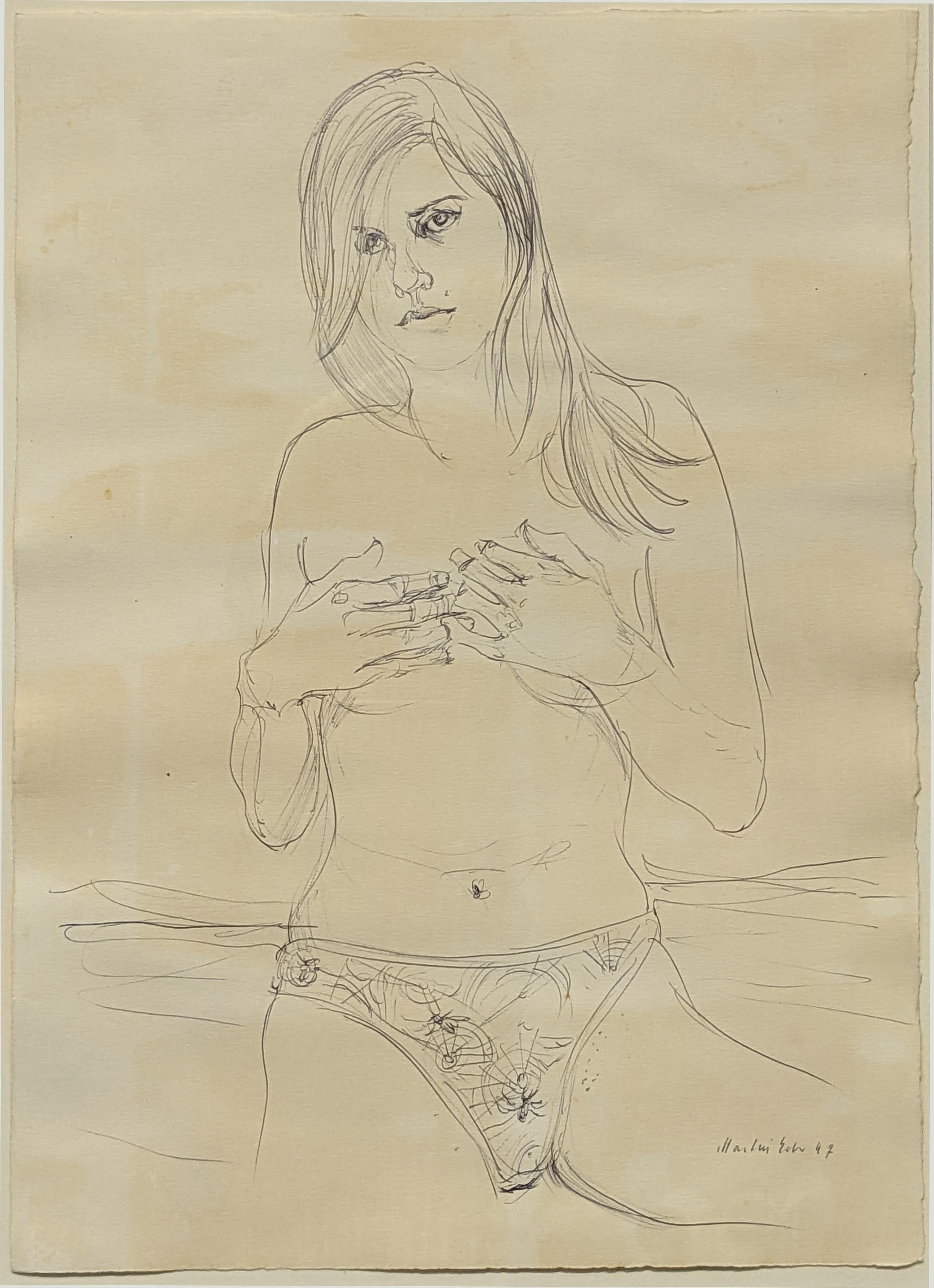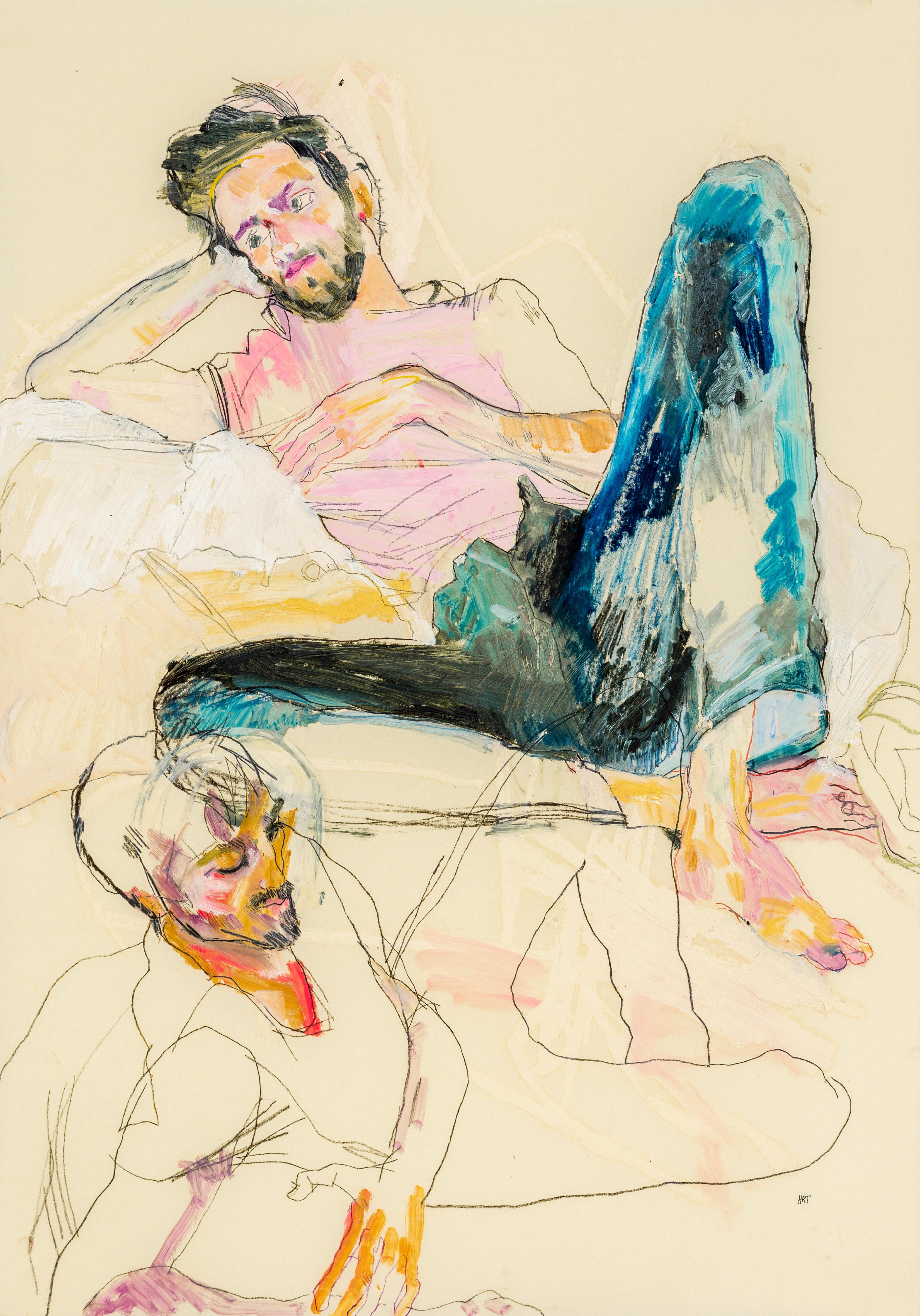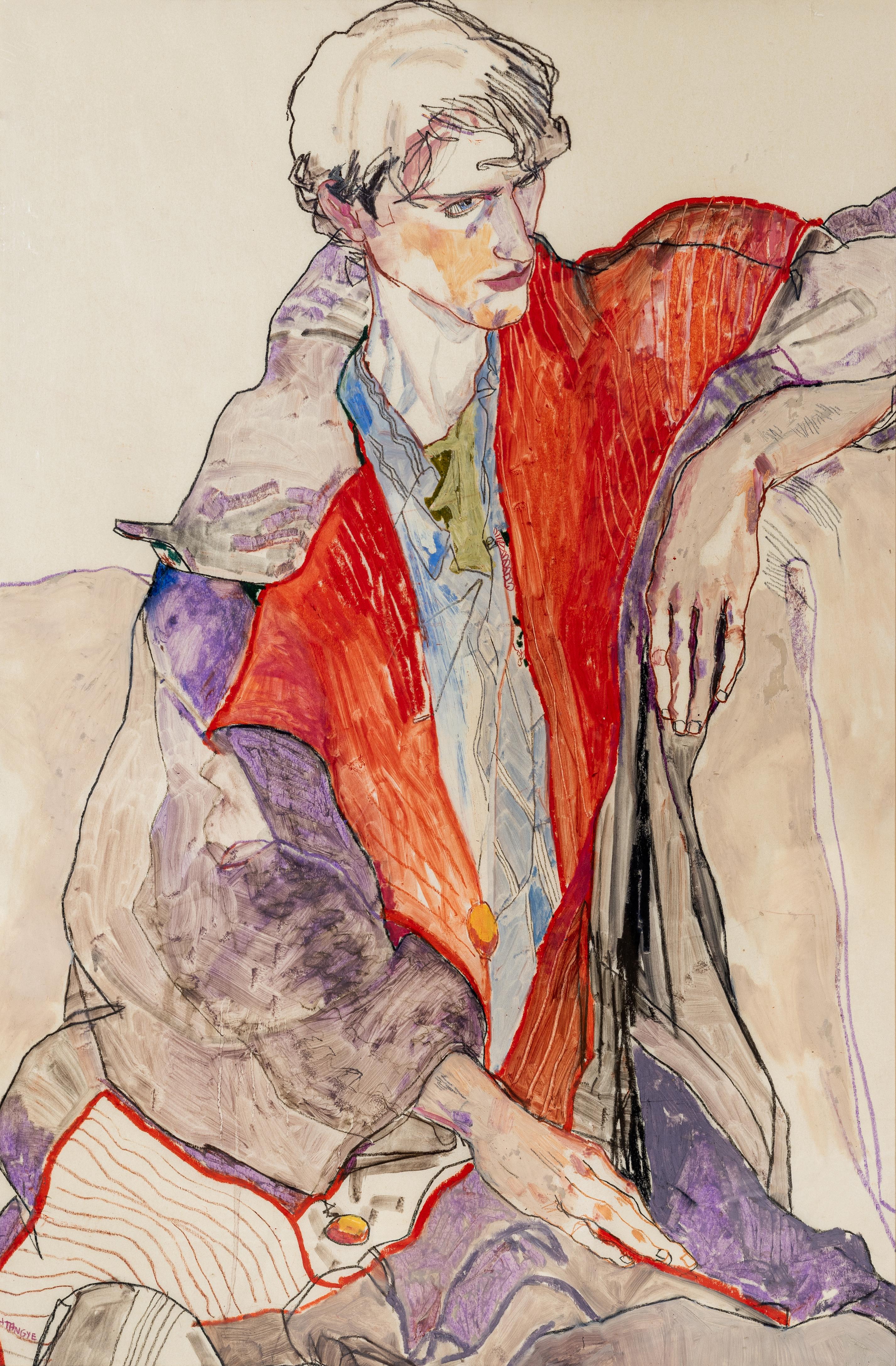Items Similar to Carnivorous Plants - Pen and Watercolor by Sergio Barletta - 1975
Want more images or videos?
Request additional images or videos from the seller
1 of 2
Sergio BarlettaCarnivorous Plants - Pen and Watercolor by Sergio Barletta - 19751975
1975
About the Item
Carnivorous Plants is an original drawing in pen and watercolor artwork on cardboard applied on black passepartout, realized by Sergio Barletta in 1975.
Hand-signed on the lower right. with the dedication of the artist on the lower right.
In very good conditions
The artwork represents plants through quick and soft strokes with vivid and congruous colors, in enjoyable harmony. Sergio Barletta (1934) is an Italian cartoonist and illustrator, who has also published some humorous and political satire books.
From the age of 22 is active in Rome, where he worked as an illustrator and art director in some monthly magazines like “Costume”, Diners Club house organ, BP Review, IBM, and others.
In 1965 started the joint-working with Marino Gallery in Rome, and in 1966 in Milan with Humour Graphic’s group, at Levi Gallery and others in the following years.
In these years graphic work and illustration are mixed with painting and photography, also with satirical drawings for Rinascita, weekly of the Italian communist party; Azione Sociale, weekly of ACLI Catholic Workers Association; movie posters, advertising for Gucci, some writings for Popular Photography Italiana, lay-outs, writings and illustrations for Avinews, bimonthly for tour operators and so on.
During the eighties he starts a long co-operation with satirical weekly “Il Sale”, complemented by a book with Ottaviano edizioni in Milan and others publications in Turin and Rome, all of satirical drawings. In this period he collaborates with Linus, the most important Italian comics monthly, and Harakiri, a humour weekly published in France.
Personal and group exhibitions of paintings, collages, drawings, photographs
Galleria Marino – Roma, 1965
Galleria Levi – Milano, 1966 Galleria Petronio – Bologna, 1967
Galleria d’arte moderna Villa Reale – Milano, 1967
Palazzo Costanzi – Trieste, 1967
Galleria del Naviglio – Milano, 1967
Galleria Marino – Roma, 1967
Galleria Libreria Renzo Cortina – Milano, 1968
Galleria Libreria Renzo Cortina – Milano, 1969
Society Art’s Club – Messina, 1970
Galleria Marino – Roma, 1970
Galleria Libreria Renzo Cortina – Milano, 1972
Galleria Marino – Roma, 1972
Galleria Il Diaframma – Milano, 1973
Galleria Libreria Renzo Cortina – Milano, 1974
Galleria Il Ventaglio – Firenze, 1975
Galleria Marino – Roma, 1975
Palazzo Gonfalonieri – Milano, 1976
Bedford House Gallery – London, 1977
Galleria Apicella – Bonn, 1979
Civico Museo Archeologico – Milano, 1980
Palazzo Barberini – Roma, 1981
Palazzo delle Stelline – Milano, 1981
Castello Sforzesco Biblioteca Trivulziana – Milano, 1982
Civico Museo Archeologico – Milano, 1983
Biblioteca Sormani – Milano, 1983
Club Migros – Milano, 1985
Centrodomus – Milano, 1985
Galleria Vittorio Emanuele – Milano, 1988
Galleria d’Arte ex libris – Roma, 1989
Civico Museo Archeologico – Milano, 1989
Palazzo delle Stelline – Milano, 1990
Palazzo d’Arte – triennale Milano, 1991
Galleria Molica Guid’Arte – Roma, 1991
Molica Gallery, West Broadway – New York, 1991
Civico Museo Archeologico – Milano, 1992
Palazzo Mediceo – Serravezza, 1994
Lalit Kala Akademi – New Delhi, 2005
Birla Academy of Art and Culture – Calcutta, 2005
Galleria Marino – Roma, 2011
- Creator:Sergio Barletta (1934, Italian)
- Creation Year:1975
- Dimensions:Height: 9.85 in (25 cm)Width: 13.98 in (35.5 cm)Depth: 0.04 in (1 mm)
- Medium:
- Period:
- Framing:Framing Options Available
- Condition:Insurance may be requested by customers as additional service, contact us for more information.
- Gallery Location:Roma, IT
- Reference Number:
About the Seller
4.9
Platinum Seller
These expertly vetted sellers are 1stDibs' most experienced sellers and are rated highest by our customers.
1stDibs seller since 2017
6,721 sales on 1stDibs
Typical response time: 2 hours
- ShippingRetrieving quote...Ships From: Rome, Italy
- Return PolicyA return for this item may be initiated within 14 days of delivery.
More From This SellerView All
- Woman with Child - Original Drawing - Mid 20th CenturyLocated in Roma, ITWoman with child is an original Drawing pen and watercolor on paper in pencil realized in the Mid-20th Century. In good condition. The artwork is depicted skillfully through confi...Category
Mid-20th Century Modern Figurative Drawings and Watercolors
MaterialsWatercolor, Pen
- The Couple - Drawing by Mino Maccari - 1960sBy Mino MaccariLocated in Roma, ITThe Couple is a Pen and watercolor drawing realized by Mino Maccari (1924-1989) in the 1960s. Hand-signed on the lower. Good conditions with some foxing Mino Maccari (Siena, 1924...Category
1960s Modern Figurative Drawings and Watercolors
MaterialsPen, Watercolor
- Landscape - Drawing By Reynold Arnould - 1977Located in Roma, ITLandscape is a black Marker Drawing and Watercolour realized by Reynold Arnould (Le Havre 1919 - Parigi 1980). Good condition on a little white paper. No signature, dated on the l...Category
1970s Modern Landscape Drawings and Watercolors
MaterialsWatercolor, Permanent Marker, Paper
- Portrait - Drawing by Mino Maccari - 1980By Mino MaccariLocated in Roma, ITPortrait is a China Drawing and Watercolor realized by Mino Maccari (1924-1989) in 1980s. Hand-signed on the lower margin. Good condition on a little cardboard. Mino Maccari (Sien...Category
1980s Modern Figurative Drawings and Watercolors
MaterialsPaper, Watercolor, Pen
- Tenderness - Drawing by Mino Maccari - 1960sBy Mino MaccariLocated in Roma, ITTenderness is a pen and watercolor Drawing realized by Mino Maccari (1924-1989) in 1960s. Hand-signed on the lower margin. Good condition. Mino Maccari (Siena, 1924-Rome, June 16...Category
1960s Modern Figurative Drawings and Watercolors
MaterialsBallpoint Pen, Watercolor
- The Couple - Drawing by Mino Maccari - 1960sBy Mino MaccariLocated in Roma, ITThe Couples is a Pen and watercolor Drawing realized by Mino Maccari (1924-1989) in the 1960s. Hand-signed at the top margin. Good conditions. Mino Maccari (Siena, 1924-Rome, Jun...Category
20th Century Contemporary Portrait Drawings and Watercolors
MaterialsWatercolor, Pen, Paper
You May Also Like
- The Abduction of the Sabine Women , a Renaissance drawing by Biagio PupiniLocated in PARIS, FRThis vigorous drawing has long been attributed to Polidoro da Caravaggio: The Abduction of the Sabine Women is one of the scenes that Polidoro depicted between 1525 and 1527 on the façade of the Milesi Palazzo in Rome. However, the proximity to another drawing inspired by this same façade, kept at the Ecole des Beaux-Arts, and to other drawings inspired by Polidoro kept at the Musée du Louvre, leads us to propose an attribution to Biagio Pupini, a Bolognese artist whose life remains barely known, despite the abundant number of drawings attributed to him. 1. Biagio Pupini, a Bolognese artist in the light of the Roman Renaissance The early life of Biagio Pupini, an important figure of the first half of the Cinquecento in Bologna - Vasari mentions him several times - is still poorly known. Neither his date of birth (probably around 1490-1495) nor his training are known. He is said to have been a pupil of Francesco Francia (1450 - 1517) and his name appears for the first time in 1511 in a contract with the painter Bagnacavallo (c. 1484 - 1542) for the frescoes of a church in Faenza. He then collaborated with Girolamo da Carpi, at San Michele in Bosco and at the villa of Belriguardo. He must have gone to Rome for the first time with Bagnacavallo between 1511 and 1519. There he discovered the art of Raphael, with whom he might have worked, and that of Polidoro da Caravaggio. This first visit, and those that followed, were the occasion for an intense study of ancient and modern art, as illustrated by his abundant graphic production. Polidoro da Caravaggio had a particular influence on the technique adopted by Pupini. Executed on coloured paper, his drawings generally combine pen, brown ink and wash with abundant highlights of white gouache, as in the drawing presented here. 2. The Abduction of the Sabine Women Our drawing is an adaptation of a fresco painted between 1525 and 1527 by Polidoro da Caravaggio on the façade of the Milesi Palace in Rome. These painted façades were very famous from the moment they were painted and inspired many artists during their stay in Rome. These frescoes are now very deteriorated and difficult to see, as the palace is in a rather narrow street. The episode of the abduction of the Sabine women (which appears in the centre of the photo above) is a historical theme that goes back to the origins of Rome and is recounted both by Titus Livius (Ab Urbe condita I,13), by Ovid (Fasti III, 199-228) and by Plutarch (II, Romulus 14-19). After killing his twin brother Romus, Romulus populates the city of Rome by opening it up to refugees and brigands and finds himself with an excess of men. Because of their reputation, none of the inhabitants of the neighbouring cities want to give them their daughters in marriage. The Romans then decide to invite their Sabine neighbours to a great feast during which they slaughter the Sabines and kidnap their daughters. The engraving made by Giovanni Battista Gallestruzzi (1618 - 1677) around 1656-1658 gives us a good understanding of the Polidoro fresco, allowing us to see how Biagio Pupini reworked the scene to extract this dynamic group. With a remarkable economy of means, Biagio Pupini takes over the left-hand side of the fresco and depicts in a very dense space two main groups, each consisting of a Roman and a Sabine, completed by a group of three soldiers in the background (which seems to differ quite significantly from Polidoro's composition). The balance of the drawing is based on a very strongly structured composition. The drawing is organised around a median vertical axis, which runs along both the elbow of the kidnapped Sabine on the left and the foot of her captor, and the two main diagonals, reinforced by four secondary diagonals. This diamond-shaped structure creates an extremely dynamic space, in which centripetal movements (the legs of the Sabine on the right, the arm of the soldier on the back at the top right) and centrifugal movements (the arm of the kidnapper on the left and the legs of the Sabine he is carrying away, the arm of the Sabine on the right) oppose each other, giving the drawing the appearance of a whirlpool around a central point of support situated slightly to the left of the navel of the kidnapper on the right. 3. Polidoro da Caravaggio, and the decorations of Roman palaces Polidoro da Caravaggio was a paradoxical artist who entered Raphael's (1483 - 1520) workshop at a very young age, when he oversaw the Lodges in the Vatican. Most of his Roman work, which was the peak of his career, has disappeared, as he specialised in facade painting, and yet these paintings, which are eminently visible in urban spaces, have influenced generations of artists who copied them abundantly during their visits to Rome. Polidoro Caldara was born in Caravaggio around 1495-1500 (the birthplace of Michelangelo Merisi, known as Caravaggio, who was born there in 1571), some forty kilometres east of Milan. According to Vasari, he arrived as a mason on the Vatican's construction site and joined Raphael's workshop around 1517 (at the age of eighteen according to Vasari). This integration would have allowed Polidoro to work not only on the frescoes of the Lodges, but also on some of the frescoes of the Chambers, as well as on the flat of Cardinal Bibiena in the Vatican. After Raphael's death in 1520, Polidoro worked first with Perin del Vaga before joining forces with Maturino of Florence (1490 - 1528), whom he had also known in Raphael's workshop. Together they specialised in the painting of palace façades. They were to produce some forty façades decorated with grisaille paintings imitating antique bas-reliefs. The Sack of Rome in 1527, during which his friend Maturino was killed, led Polidoro to flee first to Naples (where he had already stayed in 1523), then to Messina. It was while he was preparing his return to the peninsula that he was murdered by one of his assistants, Tonno Calabrese, in 1543. In his Vite, Vasari celebrated Polidoro as the greatest façade decorator of his time, noting that "there is no flat, palace, garden or villa in Rome that does not contain a work by Polidoro". Polidoro's facade decorations, most of which have disappeared as they were displayed in the open air, constitute the most important lost chapter of Roman art of the Cinquecento. The few surviving drawings of the painter can, however, give an idea of the original appearance of his murals and show that he was an artist of remarkable and highly original genius. 4. The façade of the Milesi Palace Giovanni Antonio Milesi, who commissioned this palace, located not far from the Tiber, north of Piazza Navona, was a native of the Bergamo area, like Polidoro, with whom he maintained close friendly ties. Executed in the last years before the Sack of Rome, around 1526-1527, the decoration of Palazzo Milesi is considered Polidoro's greatest decorative success. An engraving by Ernesto Maccari made at the end of the nineteenth century allows us to understand the general balance of this façade, which was still well preserved at the time. The frescoes were not entirely monochrome, but alternated elements in chiaroscuro simulating marble bas-reliefs and those in ochre simulating bronze and gold vases...Category
16th Century Old Masters Figurative Drawings and Watercolors
MaterialsInk, Gouache, Pen
- untitled / ohne TitelBy Martin EderLocated in New York, NYMartin Eder untitled work on paper executed in ballpoint pen with traces of watercolor. Ohne Titel Arbeit auf Papier, ausgeführt in Kugelschreiber mit Spuren von Aquarell. 2007Category
Early 2000s Realist Nude Drawings and Watercolors
MaterialsInk, Watercolor, Pen
- Nobu (Hands on Legs - Blue & White), Mixed media on ochre parchmentBy Howard TangyeLocated in London, GBHoward Tangye (b.1948, Australia) has been an influential force in fashion for decades. Lecturing at London’s Central Saint Martins for 35 years, includi...Category
2010s Contemporary Portrait Paintings
MaterialsPaint, Paper, Parchment Paper, Charcoal, Oil Crayon, Oil Pastel, Pastel,...
- Oleg (Kimono), Mixed media on ochre parchment paperBy Howard TangyeLocated in London, GBHoward Tangye (b.1948, Australia) has been an influential force in fashion for decades. Lecturing at London’s Central Saint Martins for 35 years, including 16 years as head of BA Wom...Category
2010s Contemporary Figurative Drawings and Watercolors
MaterialsPaint, Paper, Parchment Paper, Charcoal, Crayon, Oil Crayon, Oil Pastel,...
- Giorgio (Two figures, pink & blue), Mixed media on Pergameneta parchmentBy Howard TangyeLocated in London, GBHoward Tangye (b.1948, Australia) has been an influential force in fashion for decades. Lecturing at London’s Central Saint Martins for 35 years, including 16 years as head of BA Wom...Category
2010s Contemporary Figurative Paintings
MaterialsPaint, Paper, Parchment Paper, Charcoal, Crayon, Oil Crayon, Oil Pastel,...
- Jake II (Red coat), Mixed media on Pergameneta parchmentBy Howard TangyeLocated in London, GBHoward Tangye (b.1948, Australia) has been an influential force in fashion for decades. Lecturing at London’s Central Saint Martins for 35 years, including 16 years as head of BA Wom...Category
2010s Contemporary Figurative Paintings
MaterialsPaint, Paper, Parchment Paper, Charcoal, Crayon, Oil Crayon, Oil Pastel,...





